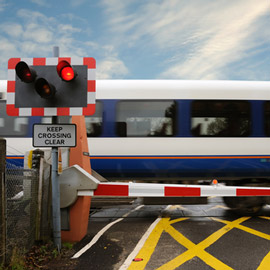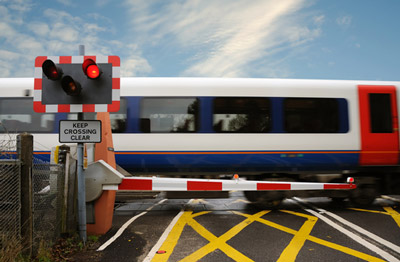Level Crossings and the Lorries of Doom
Posted: 19 May 2016 | | 2 comments
‘Ah yes, level crossings! Those locations where ill-disciplined road users interact in fascinating ways with railways…’ Regular blogger Peter Van de Mark looks at the hazards of level crossings.




Ah yes, level crossings! Those locations where ill-disciplined road users interact in fascinating ways with railways… My readers may have noticed that I entertain a few hang-ups with regard to this subject; my number one bugbear being when lorries are involved in destructive accidents at those locations. The point is they shouldn’t be! Lorries are not driven by ill-disciplined private motorists, but by professionals.


This rant is, in fact, triggered by the widely viewed YouTube videos – from no less than four camera angles – of the destruction of a lorry at Studénka railway station in the Czech Republic on 22 July 2015. It was hit and instantly demolished by Czech Railways Pendolino set 681 003 at approximately 140 km/h impact speed. The Polish driver of the articulated vehicle, with a cargo of aluminium sheet material, was avoiding motorway tolls by taking local routes, which required considerable extra travel time and caused him to encounter a level crossing. Despite displaying flashing warning lights for at least thirty seconds before-hand, for reasons known only to the driver he decided to enter the crossing anyway, to find all four barriers coming down at the same moment and trapping him. That, incidentally, points at an issue I have with this level crossing: Had the barriers come down in pairs (as should be standard practise these days, with the entrance ones first and the exit ones a couple of seconds later) and had the crossing deck been scanned by obstacle detecting equipment that opened an exit barrier in case of detecting an obstacle, then this truck would have escaped. Three lives would have been saved and several injured (the train driver lost both lower legs) would have been spared their ordeal. Additionally, had the trucker been up to speed with his job, he should have known that closed crossing barriers easily snap off by design when driving through them. However, is that really something we want society at large to know about? Saturday evening fun on the way home from the pub? Anyhow, the trucker escaped serious physical harm and is presently awaiting trial.
“Had the barriers come down in pairs and had the crossing deck been scanned by obstacle detecting equipment that opened an exit barrier in case of detecting an obstacle, then this truck would have escaped”
Should this be something that occurs once every so many years – and for entirely understandable reasons – one could shrug the shoulders and mumble ‘bad luck’. However, that isn’t the case. Only a year later, an electric multiple unit train at speed hit a slow moving tracked machine on an Automatic Half Barrier (AHB) level crossing at Dalfsen in The Netherlands. That train driver lost his life and the damage was considerable. What is surprising is that the international road transport fraternity- who by now have quite a number of accidents caused by ignorance to study – appears unable to cotton on to the fact that automatic railway crossings actually are dangerous venues. This is certainly true if you’re using big vehicles with expensive loads, yet are not prepared to study level crossing functioning and abide by a few rules. That steady ignorance, identifying educational as well as discipline issues, is actually disturbing. Have a look at the short listing below (it is a quick snap-shot and not attempting to be anywhere near complete):
- Hixon, UK, 06 January 1968, 11 dead. Widely publicised and anyone with a professional interest in heavy transport could have known about the dangers of automatic level crossings after the event. Main causes: bad scouting and, crucially, no contact with the rail operator.
- Kissimmee, FL, USA, 30 November 1993, no fatalities. Amtrak passenger train crashes into a gas turbine electric power generator being delivered to Cane Island power plant. Main causes: bad scouting, bad preparation and no contact with rail operator.
- Kissimmee, FL, USA, 17 November 2000, no fatalities. Absolutely unbelievable, yet true: exactly the same accident with very similar equipment happens again seven years later. Short memory span at work.
- Tossiat, F, 30 January 2003, one dead. Heavy road paving machinery hit by a TGV at approximately 150 km/h. Driver of road freight vehicle dead. Main causes: Convoy was off permitted route, badly scouted and failed to contact rail traffic control.
- Domène, F, 18 October 2006, no fatalities. Oversize transport hit by a local rail service and destroyed. Main cause: failure to contact rail traffic control.
- Kerang, Vict, AUS, 05 June 2007, 11 dead. Trucker overlooks unsatisfactorily displayed warning indications of an Automatic Open Crossing and runs at 100 km/h into 2nd of 3-coach train. Right hand front corner of trailer slices into the side of the last two coaches.
- Halifax, NC, USA, 09 March 2015, 55 injured and no fatalities. Amtrak “Carolinian” hits heavy road transport attempting to cross whilst negotiating sharp curves.
- Studénka, CZ, 22 February 2016, three dead. Pioneering foreign trucker makes a mess of passing a level crossing. Vehicle hit by express train at 140 km/h.
- Dalfsen, NL, 23 February 2016, one dead. Tree Surgeon Company contracted by the rail network operator rolls a heavy and slow tracked vehicle across the level crossing. An approaching local train cannot be stopped and hits at 100 km/h. Yet again, simple contact with rail traffic control would have identified a safe moment to cross.
- Chester, PA, USA, 03 April 2016, two construction workers dead. Electrically hauled Amtrak “Palmetto” hits erroneously present heavy engineering equipment at 106 mph (170 km/h).
“That steady ignorance, identifying educational as well as discipline issues, is actually disturbing”
A short trawl through videos available at LiveLeak and YouTube will present four times this number of heavy road vehicles all over the world getting smashed up on level crossings. Given that the situation merely requires a smidgen of operational insight when organising the trip – to contact, among others, the relevant rail traffic controllers – this listing points at a lack of imaginative yet practical insight. Additionally, there seems to be a dangerous habit among heavy plant movers to solve problems as and when they occur, which is another way of saying that scouting must appear a bit of a joke. However, if your vehicle with its precious cargo is stuck and straddling the tracks of a busy railway line, it is the last and very costly mistake you will make. In consideration of the railways, therefore; knowing that growing international awareness from the side of road users cannot be ensured, it might be deemed beneficial, and save lives, if they took the initiative on a European level to inform the large number of people involved in heavy road transport, in offices and behind steering wheels, about the dangers of automatic level crossings.



You can add another one to your list, Naas level crossing, Gloucestershire, on March 1 1979.
“The level crossing at Naas Lane was notorious for being inappropriately used as a short cut to a trading estate and no more so than on this fateful day.
“The barriers had been left up that morning and driver Leslie Small drove his 13 tonne skip lorry on to the crossing at around 8.15am, just as the 7.40am Cardiff to Newcastle express bore down on the crossing at 60 mph.
“The train ripped the truck to shreds, killing the driver outright by decapitation. The cab of the 133 tonne diesel locomotive was totally crushed, killing the train driver Harry Hitchens, 59, and secondman Philip Ball, 38.”
I was involved with level crossings on the Western at the time, saw photos of the incident, and it was clear the driver and second man did not stand a chance.
Thanks for your reaction, Garth. Naas had a very different character, though. It was a User Worked Crossing with Miniature Warning Lights and road-user operated barriers. The problem was, as indeed it turned out in the rest of the world, that these barriers were left open time and again. This led the driver of a household refuse lorry, admittedly overlooking the Miniature Warning lights, to cross without properly scanning the track. His appreciation of the situation was probably based on the idea that open barriers indicated that no train was approaching. In “An Unexpected End to the Journey” this road user psychological mechanism is dealt with in some depth based on similar accidents at Moulinearn in Scotland.